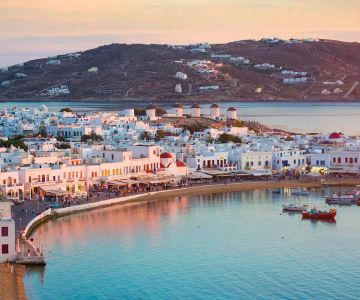How to Plan a Multi-Destination Trip in Europe: Essential Travel Tips
- 1. Why Choose a Multi-Destination Trip in Europe?
- 2. Selecting Your Destinations
- 3. Creating Your Itinerary: Tips and Tricks
- 4. Transportation Options for Multi-Destination Trips
- 5. Budgeting for a Multi-Destination European Trip
- 6. Real-Life Examples of Successful Multi-Destination European Trips
1. Why Choose a Multi-Destination Trip in Europe?
Europe is a continent rich with diverse cultures, landscapes, and history. One of the best ways to experience its vast offerings is by planning a multi-destination trip. Unlike visiting a single city or country, a multi-destination trip allows you to immerse yourself in multiple European cultures and landmarks in one journey.
A multi-destination trip lets you explore more than just the highlights. Imagine sipping espresso in Rome, marveling at the art in Paris, and wandering through the historic streets of Prague—all in one trip. With the right planning, you can design an itinerary that captures the essence of Europe’s most iconic cities and hidden gems.
2. Selecting Your Destinations
When planning a multi-destination trip, the first step is to choose your destinations wisely. Europe offers a wealth of travel possibilities, so narrowing down your options can be a challenge. Here’s how to approach it:
2.1 Consider Your Interests
Do you love history, art, food, or nature? Europe is known for its diversity, and every destination offers something unique. For example, if you’re a fan of Renaissance art, Florence or Rome in Italy should be on your list. If you’re a history buff, cities like Berlin or Athens will captivate you with their ancient landmarks.
2.2 Think About Geography
While it’s tempting to hop between cities in distant corners of Europe, it’s important to consider geographical proximity when planning your route. For example, a trip that includes both Paris and Madrid will require more time and effort than combining cities like Amsterdam, Brussels, and Cologne, which are all just a short train ride apart. Grouping nearby destinations helps maximize your time and minimize travel time.
2.3 Factor in Local Events and Seasons
Don’t forget to check the local events calendar and weather conditions before booking your destinations. Festivals, special exhibitions, and weather conditions can significantly enhance or impact your experience. For instance, summer in the Mediterranean offers beautiful weather, while springtime in cities like Amsterdam brings stunning tulip blooms.
3. Creating Your Itinerary: Tips and Tricks
Once you’ve chosen your destinations, it’s time to create a travel itinerary. An effective itinerary will balance sightseeing with downtime to prevent burnout.
3.1 Be Realistic About Travel Time
Europe’s excellent transportation network means you can travel between cities relatively quickly, but be mindful of travel time. For example, a train ride from London to Paris takes about 2.5 hours, but traveling from Paris to Vienna may take up to 12 hours by train. Allocate enough time for travel, but don’t cram too much into a single day.
3.2 Mix Popular Destinations with Hidden Gems
While it’s tempting to visit only the most famous cities—Paris, Rome, Barcelona—it’s also worth including lesser-known gems. Cities like Porto, Lisbon, or Zagreb offer unique experiences without the overwhelming crowds of major tourist destinations. Balancing popular spots with hidden treasures makes your trip more diverse and enriching.
3.3 Leave Room for Flexibility
Traveling through multiple destinations means there may be unexpected opportunities to explore. Perhaps you’ll stumble upon a quaint village or decide to extend your stay in a city you’ve fallen in love with. Leave a little room in your itinerary for spontaneity to fully enjoy your European adventure.
4. Transportation Options for Multi-Destination Trips
Europe’s extensive transportation system offers plenty of options for getting from one destination to the next. Choosing the right method depends on the distance, your budget, and the experience you’re looking for.
4.1 Trains
Train travel in Europe is efficient and scenic, making it an excellent choice for a multi-destination trip. The Eurail pass offers unlimited travel across multiple countries, allowing for flexible schedules and routes. Cities like Paris, London, and Amsterdam are well-connected by high-speed trains, making them easy to visit on a tight schedule.
4.2 Budget Airlines
If you’re traveling longer distances, budget airlines like Ryanair or EasyJet can be a time-efficient and cost-effective option. However, be aware of extra fees and airport locations, as they may not always be as convenient as train stations in city centers.
4.3 Buses
Buses are often the most affordable way to travel between destinations, although they take longer. Companies like Flixbus cover a wide range of routes across Europe and can be an excellent choice for budget-conscious travelers.
5. Budgeting for a Multi-Destination European Trip
One of the most important aspects of planning a multi-destination trip is budgeting. With multiple cities on your itinerary, costs can add up quickly. Here’s how to manage your finances:
5.1 Accommodation
Accommodation costs can vary significantly across Europe, depending on the destination and the time of year. Major cities like Paris and Rome tend to be more expensive, while smaller towns or off-season travel may offer better deals. Booking accommodations in advance can help you lock in lower rates.
5.2 Food and Dining
Dining in Europe can range from affordable street food to Michelin-star restaurants. Plan your meals to suit your budget, and don’t forget that many cities offer free walking tours, which often include food stops along the way. Additionally, shopping at local markets and cooking your own meals can save money while offering a more authentic experience.
5.3 Activities and Attractions
Many European attractions, such as museums, castles, and historic sites, offer discounts for students, seniors, or group bookings. Always check for special offers or city passes that provide discounted entry to multiple attractions.
6. Real-Life Examples of Successful Multi-Destination European Trips
Real-life stories can offer insight into the best way to plan a multi-destination trip. For example, a couple traveling through Spain, Italy, and France spent two weeks exploring these countries. They chose nearby cities and blended historical sights with cultural experiences like cooking classes and wine tours, creating a balanced itinerary. Their success lay in the thoughtful pacing and a mix of iconic landmarks with local experiences.
If you’re inspired by the idea of a multi-destination European adventure, start planning your journey today. Whether it’s exploring the art-filled streets of Florence or the romantic canals of Venice, Europe has something for every traveler. For more information and expert advice on planning your perfect European getaway, visit [travel clans].







 Coney Island Boardwalk Garden4.0 (75 reviews)
Coney Island Boardwalk Garden4.0 (75 reviews) The William Hotel Midtown, Sonder4.0 (555 reviews)
The William Hotel Midtown, Sonder4.0 (555 reviews) Shepard Lake Recreation Area0.0 (0 reviews)
Shepard Lake Recreation Area0.0 (0 reviews) Stairway To Heaven4.0 (185 reviews)
Stairway To Heaven4.0 (185 reviews) Howard Bennett Playground4.0 (152 reviews)
Howard Bennett Playground4.0 (152 reviews) Isle of Meadows4.0 (10 reviews)
Isle of Meadows4.0 (10 reviews) Top Group Travel Destinations in Europe: Best Places for Group Vacations
Top Group Travel Destinations in Europe: Best Places for Group Vacations Best Travel Clans for Sustainable Travel
Best Travel Clans for Sustainable Travel How to Get Involved in Travel Clans for Social Travel: Explore Group Travel Opportunities
How to Get Involved in Travel Clans for Social Travel: Explore Group Travel Opportunities Best Group Vacation Destinations for Friends: Ultimate Travel Ideas
Best Group Vacation Destinations for Friends: Ultimate Travel Ideas Travel Clans for Solo Travelers Looking for Company: Join Unique Travel Communities
Travel Clans for Solo Travelers Looking for Company: Join Unique Travel Communities Best Travel Clans for Women Traveling Together
Best Travel Clans for Women Traveling Together